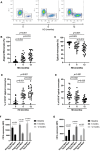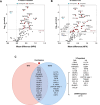New biomarkers of inflammation associated with haemodialysis
- PMID: 40832121
- PMCID: PMC12358798
- DOI: 10.1093/ckj/sfaf223
New biomarkers of inflammation associated with haemodialysis
Abstract
Background: The first year of haemodialysis (HD) carries the highest risk of mortality, which to a large extent is attributed to the aggravation of inflammation. However, traditional markers such as C-reactive protein and interleukin-6 show only minor changes during the first year, suggesting that there are other factors involved. The present study evaluates the effect of HD on microinflammation and oxidative stress of uremic patients.
Methods: We conducted a prospective observational longitudinal study including 30 incident HD patients. Blood samples were collected at baseline and 6 and 12 months. Pro-inflammatory monocytes were quantified using flow cytometry. Proteomic analysis (Olink) was performed on serum. Concentrations of indoxyl sulphate (IS), growth differentiation factor 15 (GDF-15), oxidative status and circulating microRNA (miRNA) expression were also determined.
Results: A new population of activated monocytes was identified that progressively increased at 1 year of HD. In addition, an increase in the serum concentration of up to 29 inflammation-related proteins was detected, including interleukins, chemokines, tumour necrosis factor family molecules, cell activation molecules and apoptosis-related proteins. Conversely, leukaemia inhibitory factor receptor was downregulated. The concentration of IS was positively correlated with GDF-15 levels. Furthermore, patients exhibited decreased expression of miRNA-126-3p, -130a-3p, -146a-5p, 223-3p, -let7a-5p and -let7b-5p.
Conclusion: This study highlights the impact of HD on inflammation and oxidative stress, manifested by an increase in activated monocytes and inflammatory markers. The observed subclinical inflammation associated to HD treatment may help in understanding the mechanisms of cardiovascular damage in patients on HD.
Keywords: cardiovascular disease; haemodialysis; inflammation; monocytes; uraemic toxins.
© The Author(s) 2025. Published by Oxford University Press on behalf of the ERA.
Conflict of interest statement
The authors have no conflicts of interest to declare.
Figures






References
LinkOut - more resources
Full Text Sources
Research Materials

